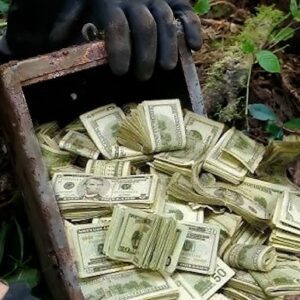Every little boy dreams of finding buried treasure, hidden by pirates or an ancient king. While adults may abandon these whimsical dreams, adventurers do not lose all hope. Hidden treasures, also known as hoards, are still found all over the world. To this day, ordinary people continue to come across caches of ancient coins, gold bracelets and silver plates.
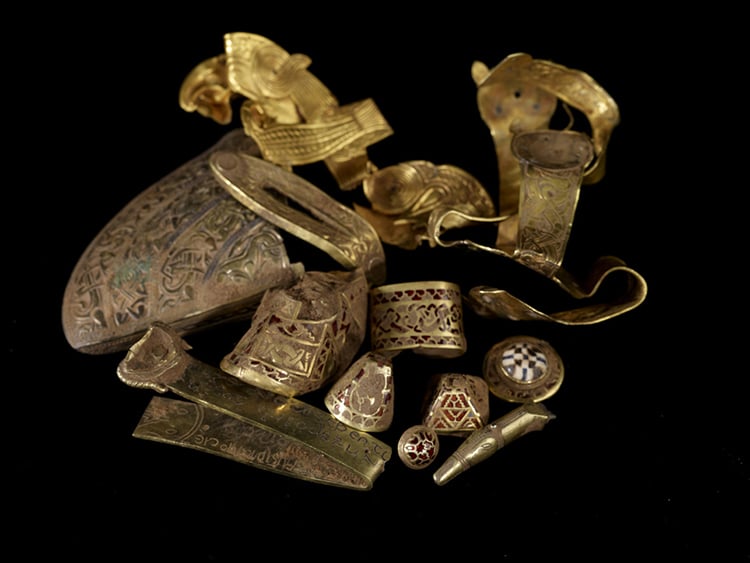
Finding hidden treasure can make someone millions, changing the life of a metal detectorist or farmer in a new direction. Each discovery also advances knowledge of local history in invaluable ways. Read on to learn more about treasures, treasures, and how your childhood dream could (maybe) still come true.
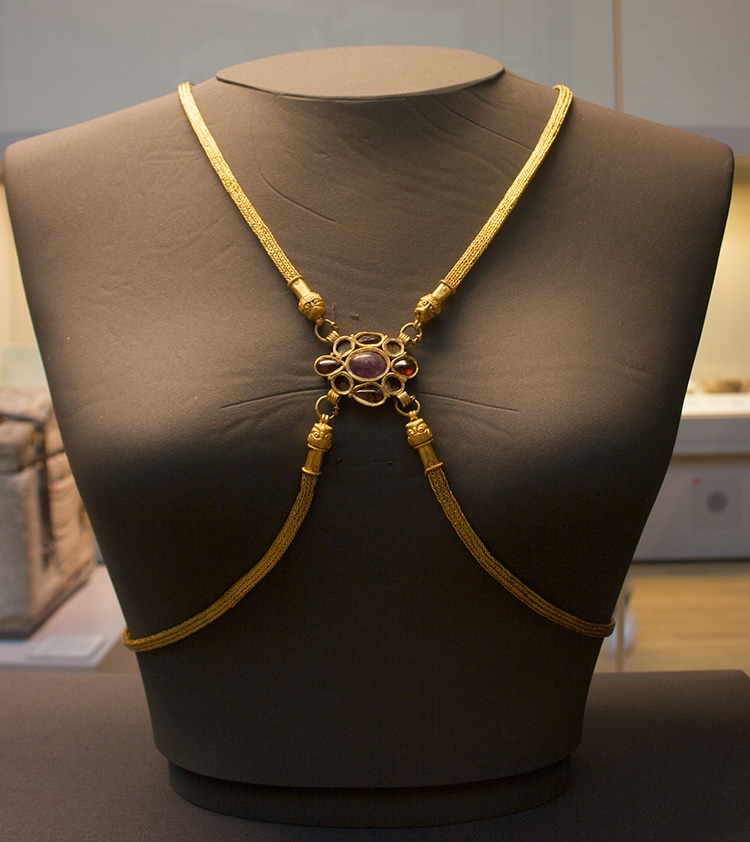
What is a hidden treasure or treasure?
Archaeologists define hidden treasures or hoards as a type of store of wealth. Precious stones and metals, ceremonial artifacts and everyday coins: treasures can comprise a variety of different metal-based objects. How these pieces become underground may depend on social conditions. Political instability or war in ancient times could inspire the wealthy to hide their valuables. Normally, these people intended to return to recover their deposited wealth. Circumstances, such as war or death, could interrupt recovery, leaving the treasure awaiting chance discovery. In general, valuables found in graves or shipwrecks are not classified as treasure.

Treasures can be found all over the world; However, Great Britain and Ireland can boast some of the largest and most famous discoveries. Hidden Treasure also has an important legal definition. Coins and bullion are defined as treasures based on the silver and gold content, as well as the age of the items. In the UK, the Treasury Act 1996 governs all discoveries. In general, any find that is more than 300 years old and contains at least 10 percent gold or silver qualifies as treasure. Prehistoric finds often qualify as well, regardless of metal content. Discoveries must be reported to the local coroner within 14 days, as the treasure found has long been considered Crown property. Concealing the discovery can even result in prison.

The coroner then carries out an inquest (or investigation) to see if the discovered objects are actually treasure. A Treasury Valuation Committee made up of experts examines the pieces. The committee decides whether the find meets the definition of treasure and then makes an appraisal. If the items are indeed within the scope of the law, the finder (and the landowner) must offer the pieces for sale in a museum. These laws exist to ensure that historic national treasures go to institutions where they will be studied, rather than simply disappearing into the hands of private collectors. Overall, this plan works well for everyone involved: the knowledge is advanced and the treasure hunters make good money from its sale.


A golden treasure ship from Broighter Gold. (Photo: Ardfern via Wikimedia Commons [CC BY-SA 3.0]) This cache of Iron Age gold was found in Northern Ireland by farmers in 1896. The gold, which dates back to the 1st century BC. C., is an excellent example of intricate metal work.
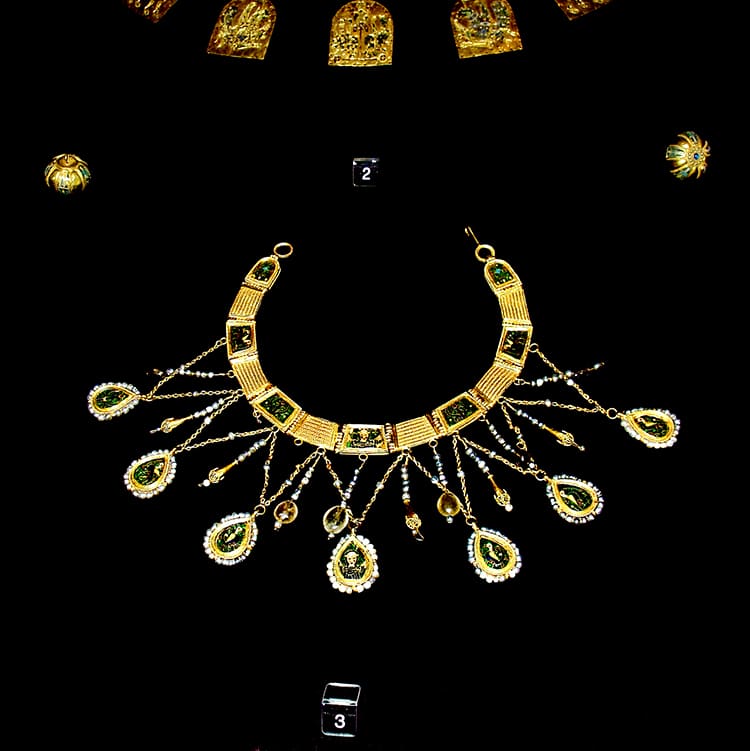
Discovered in 1978 in Castana, Bulgaria, the Preslav Treasury comprises 170 Byzantine artifacts in gold, silver and bronze. The coins date to the 10th century AD, when the items were buried during political upheaval; However, other items may date back to the 3rd century AD. The highlight of the treasure is a large gold necklace with a medallion of the Virgin Mary. It is possible that the necklace was a wedding gift from a Bulgarian tsar to a Byzantine princess.
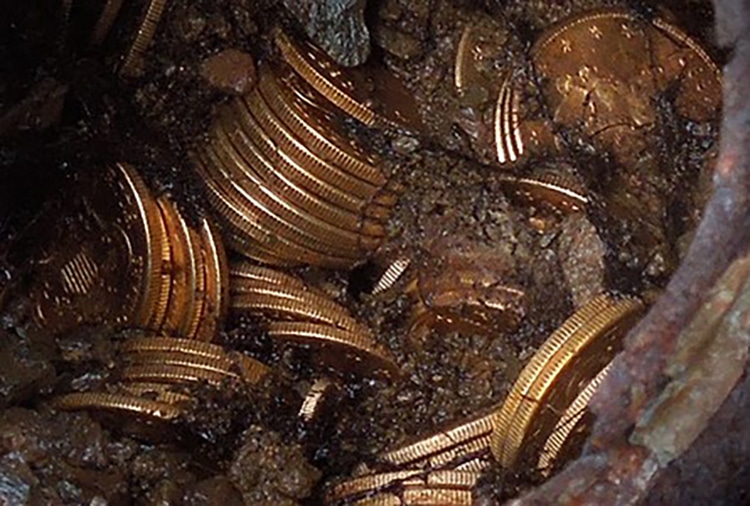
Coins as they were found in the Saddle Ridge Hoard of the Sierra Nevada Mountains of California. (Photo: Kagin’s Inc. via Wikimedia Commons [CC BY-SA 3.0])
The largest buried coin hoard discovered in the United States, the Saddle Ridge Hoard, containing 1,427 gold coins, was discovered in the Sierra Nevada Mountains in 2013. Valued at $10 million, the coins date to the second half of the 19th century. They were discovered in eight metal canisters, which the owners saw while walking their dog. The coins were preserved by numismatic experts, valued, and sold (for a lot!) through Amazon.
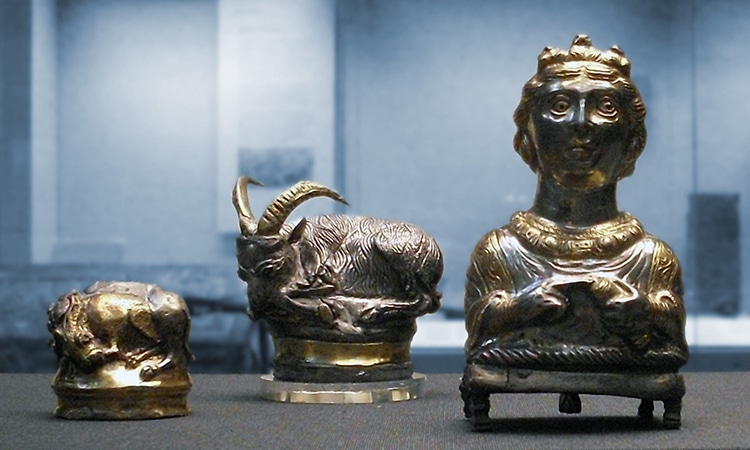
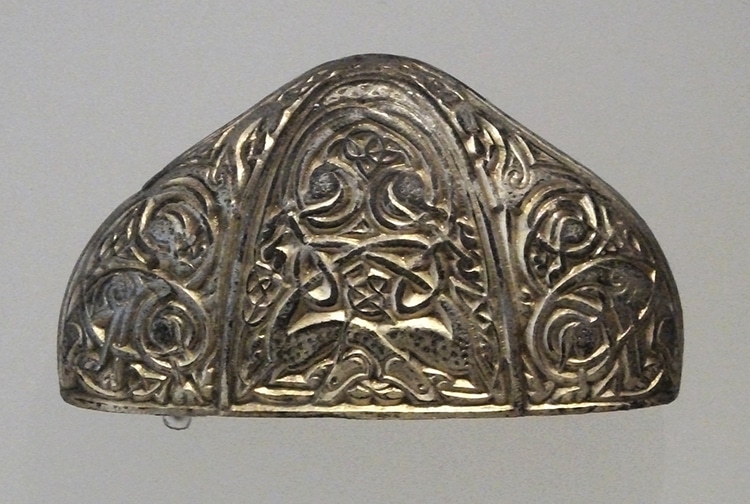
The hilt of a sword from the treasure of Saint Ninian Island. (Photo: Johnbod via Wikimedia Commons [CC BY-SA 3.0])
The Scots also have their hidden treasures. Discovered in 1958, this early medieval silver hoard includes delicate jewelery still seen in Scotland today. The penannular brooch , or Celtic brooch, held the fabric of ancient costumes, but the design is still used today for classical highland clothing. Also among the items found was an intricate sword pommel with Celtic designs in relief.
The Staffordshire Treasure
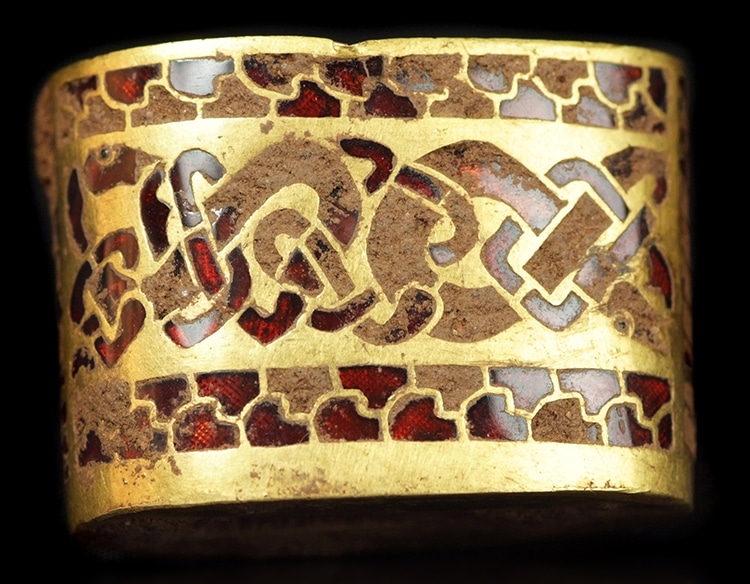
Staffordshire Hoard Anglo-Saxon gold bracelet. (Photo: Grip adjustment via Wikimedia Commons [CC BY 2.0])
The most impressive Anglo-Saxon buried hoard discovered in the UK, Staffordshire Hoard, features thousands of gold and silver items, some inlaid with garnet. Discovered in a plowed field in 2009, these special artifacts were (thankfully) excavated by professional archaeologists at the request of the landowner. As a result, historians gained a window into Britain in the 7th and 8th centuries. The collection of martial objects is famous for its craftsmanship; These objects may have been a noble votive offering at the death of a warrior.
The Mildenhall Treasure

Bacchus on the large Roman plate from the Mildenhall Treasury. (Photo: JMiall via Wikimedia Commons [CC BY-SA 3.0])
Discovered in 1942 in Suffolk, England, this is a very heavy treasure. Platters, plates, floors and spoons from Roman Britain depict mythical scenes in relief. Scholars were once skeptical about the provenance (origin) of the treasure; However, later finds confirmed that such luxuries existed in the Roman provinces. Among the cutlery is the Great Plate that represents the god of wine, Bacchus. The man who discovered silver, who is no stranger to fine silver, used the plates on special occasions before finally turning them over to the proper authorities.
Ziwiye’s treasure
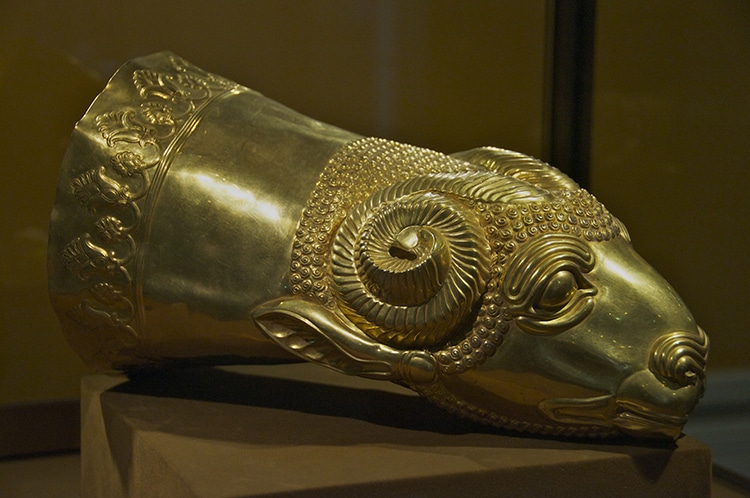
A golden rhyton (drinking horn) shaped like a ram’s head from the Ziwiye hoard. (Photo: A. Davey via Wikimedia Commons [CC BY 2.0])
The ancient Near East has impressive hidden treasures, among them is the Ziwiye Treasure. Discovered in Iran in 1947, the details of its discovery are quite confusing. Many pieces have been dispersed into private collections, part of the exploitative antiquities trade that accompanied Western imperialism in the Middle East. However, certain impressive elements have come to define the cultural diversity of ancient Iran around the 9th century BC. Located on the Silk Road and other trade routes, the items show Assyrian , Scythian , and other regional influences. Particularly impressive is a golden rhyton shaped like a ram’s head, a cup fit for a king.
The treasure of spills
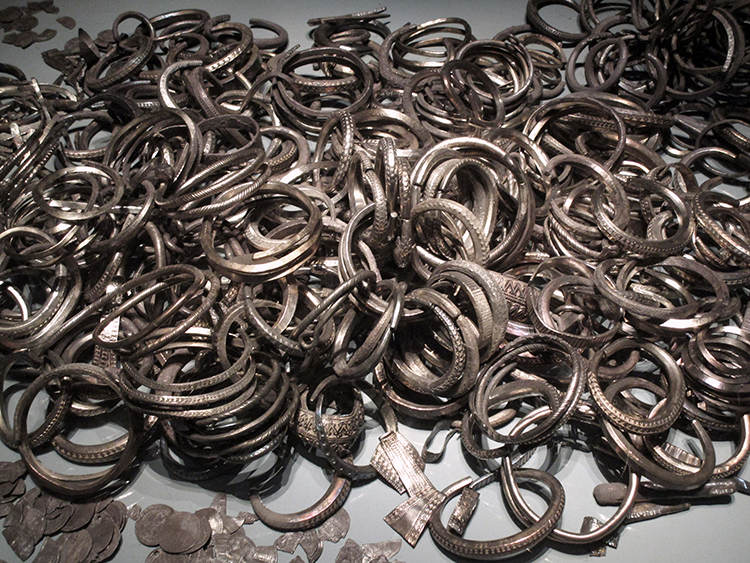
Viking silver from the Swedish Spillings hoard. (Photo: W. carter via Wikimedia Commons [CC BY-SA 4.0])
Did you know that the Vikings buried treasure? A Swedish cache of Viking silver discovered in 1999, the hoard included thousands of coins from the early medieval century. Most of the coins were of Islamic origin. This find, as well as others in Sweden, demonstrate the extent of trade in the period. Viking deposits include coins from as far away as North Africa and Central Asia.
The Treasure of Villena

Gold objects from the Villena Treasury.
Apparently, hiding valuable things has long been a human instinct. Around the year 1000 BC. C., Bronze Age Spaniards buried gold bowls, bottles, and bracelets along with iron (also considered valuable at the time). These gold items feature raised patterns and are evidence of advanced gold-working skills in prehistoric times.
The Panagyurishte Treasure

Thracian gold artifacts from the Panagyurishte hoard. (Photo: Ann Wuyts via Wikimedia Commons [CC BY 2.0])
Discovered in Bulgaria in 1949, the Panagyurishte treasure is Thracian gold . The Thracians were ancient Indo-Europeans who lived in the Balkans and Anatolia. The gold objects were buried between 400 and 300 BC Mentioned in the Iliad, the Thracians are a fascinating ancient people. (You can learn more about its history at HistoryHit.)
Wonoboyo’s treasure
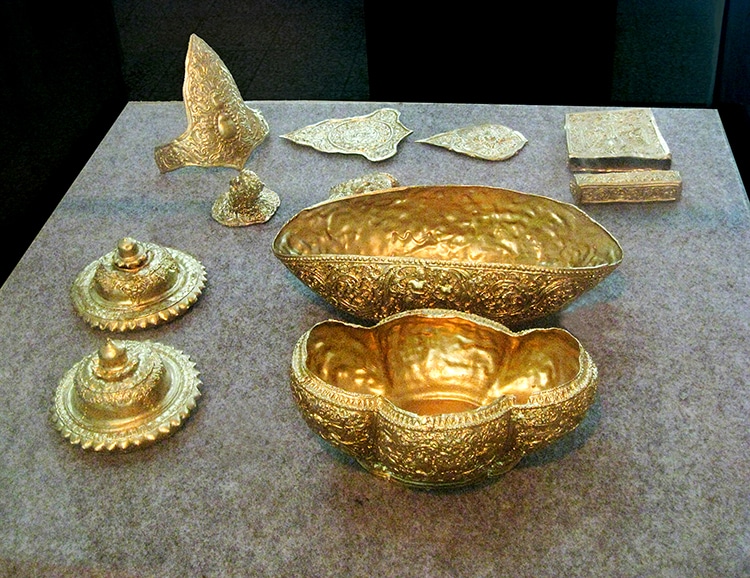
Replicas of gold objects found in the Wonoboyo hoard, discovered in 1990 in Central Java, Indonesia. (Photo: Gunawan Kartapranata via Wikimedia Commons [CC BY-SA 3.0])
The Wonoboyo treasure was discovered in 1990 in Central Java, Indonesia. These 9th century gold artifacts from the Medang Kingdom (jewelry and small bowls of exceptionally fine quality) were found buried in clay jars. Experts have suggested that the items belonged to a member of the royal family. Javanese gold is an ancient and exquisite tradition that is virtually unparalleled anywhere else; To see some of the finest gold craftsmanship, visit the Javanese collections at the Metropolitan Museum of Art.
Dream of a fabulous treasure, like when you were a child.
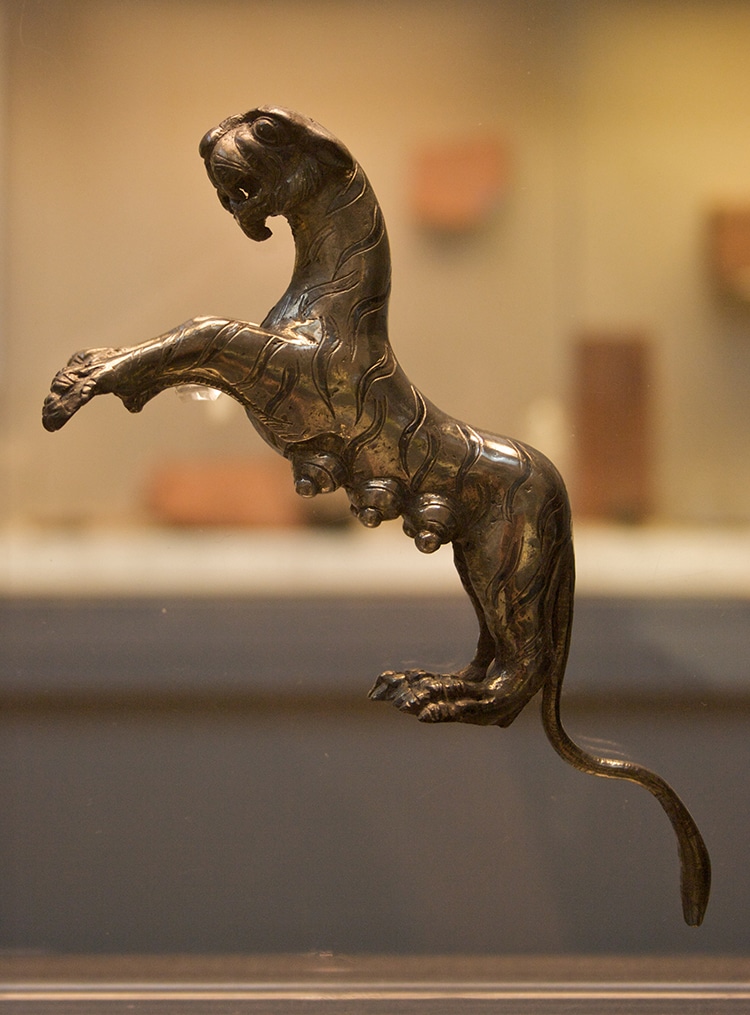
A tigress-shaped handle from the Hoxne Hoard. (Photo: Mike Peel via Wikimedia Commons [CC BY-SA 4.0])
Related Posts:
Buried treasure chest worth $2 million discovered in Rocky Mountains
This armless sculpture is one of the Louvre’s most precious masterpieces
Visually satisfying arrangements of hidden treasures pulled from Amsterdam’s river
Intriguing family portraits feature prized items


